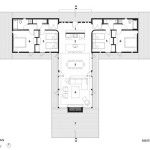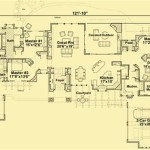A house plan is a detailed set of instructions that outlines the design, structure, and layout of a house. It typically includes floor plans, elevations, and sections, and it serves as a blueprint for the construction of the home. House plans are essential for obtaining building permits and ensuring that the house is built to code.
Creating a house plan can be a complex and time-consuming process, but it is also an incredibly rewarding one. With careful planning and attention to detail, you can design a home that is both beautiful and functional. In this article, we will walk you through the steps involved in creating a house plan, from the initial concept to the final construction documents.
Before you begin, it is important to gather some basic information about your needs and wants. Consider the size of your family, your lifestyle, and your budget. You should also think about the location of your home and the style of architecture you prefer. Once you have a good understanding of your needs, you can begin to develop a floor plan.
Here are 8 important points about how to make a house plan:
- Determine your needs
- Choose a style
- Create a floor plan
- Draw elevations
- Create sections
- Obtain building permits
- Hire a contractor
- Build your home
By following these steps, you can create a house plan that meets your needs and helps you build the home of your dreams.
Determine your needs
The first step in creating a house plan is to determine your needs. This includes considering the size of your family, your lifestyle, and your budget. You should also think about the location of your home and the style of architecture you prefer.
- Family size: How many people will be living in the house? Do you have children? Do you plan on having more children in the future? The size of your family will determine the number of bedrooms and bathrooms you need.
- Lifestyle: How do you live? Do you entertain often? Do you have hobbies that require a lot of space? The way you live will influence the layout of your home and the types of rooms you need.
- Budget: How much money can you afford to spend on your home? Your budget will determine the size and style of your home, as well as the materials and finishes you can use.
- Location: Where do you want to live? The location of your home will affect the climate, the topography, and the availability of amenities. You should also consider the zoning laws in your area, which may restrict the type of home you can build.
- Architectural style: What style of architecture do you prefer? There are many different architectural styles to choose from, including traditional, modern, contemporary, and rustic. The style of your home will influence its overall appearance and the types of materials and finishes you use.
Once you have considered all of these factors, you can begin to develop a floor plan that meets your needs.
Choose a style
The style of your home will influence its overall appearance and the types of materials and finishes you use. There are many different architectural styles to choose from, each with its own unique characteristics.
- Traditional: Traditional homes are typically symmetrical and have a formal appearance. They often feature columns, pediments, and other classical details. Traditional homes are popular in many parts of the country, and they can be a good choice for families who want a classic and timeless look.
- Modern: Modern homes are characterized by their clean lines and simple forms. They often have large windows and open floor plans. Modern homes are popular in urban areas, and they can be a good choice for families who want a contemporary and stylish look.
- Contemporary: Contemporary homes are similar to modern homes, but they often incorporate more innovative and experimental design elements. Contemporary homes can be a good choice for families who want a home that is both stylish and unique.
- Rustic: Rustic homes are characterized by their use of natural materials and finishes. They often have exposed beams, stone fireplaces, and wood floors. Rustic homes are popular in rural areas, and they can be a good choice for families who want a home that is both cozy and inviting.
Once you have chosen a style for your home, you can begin to develop a floor plan that is consistent with that style.
Create a floor plan
A floor plan is a two-dimensional drawing that shows the layout of a house. It includes the location of the rooms, walls, doors, and windows. A well-designed floor plan will create a home that is both beautiful and functional.
- Start with a rough sketch. Begin by drawing a rough sketch of your desired layout. This doesn’t need to be to scale, but it should give you a general idea of the size and shape of each room.
- Consider traffic flow. When designing your floor plan, think about how people will move through the house. You want to create a layout that is both efficient and comfortable.
- Use standard room sizes. There are standard sizes for different types of rooms. For example, a master bedroom is typically 12′ x 15′, and a kitchen is typically 10′ x 12′. Using standard room sizes will make it easier to find furniture and appliances that fit your space.
- Don’t forget about storage. Every home needs storage space. When designing your floor plan, be sure to include closets, pantries, and other storage areas.
Once you have a rough sketch of your floor plan, you can begin to refine it. Use graph paper to draw a to-scale plan. This will help you to ensure that your floor plan is accurate and that all of the rooms are the correct size.
Draw elevations
Elevations are two-dimensional drawings that show the exterior of a house from different sides. They are used to show the height and shape of the house, as well as the location of the windows and doors. Elevations are important for obtaining building permits and for ensuring that the house is built to code.
- Front elevation: The front elevation shows the front of the house. It should include the main entrance, as well as any other features that are visible from the street.
- Rear elevation: The rear elevation shows the back of the house. It should include the back door, as well as any other features that are visible from the backyard.
- Side elevations: The side elevations show the sides of the house. They should include the windows and doors that are located on the sides of the house.
- Roof plan: The roof plan shows the shape and pitch of the roof. It should also include the location of any chimneys or skylights.
When drawing elevations, it is important to use the same scale as the floor plan. This will help to ensure that the elevations are accurate and that the house is built to the correct proportions.
Create sections
Sections are two-dimensional drawings that show the interior of a house from different angles. They are used to show the height and shape of the rooms, as well as the location of the walls, doors, and windows. Sections are important for obtaining building permits and for ensuring that the house is built to code.
- Transverse section: The transverse section shows the house from one side to the other. It should include the main rooms of the house, as well as the location of the stairs.
- Longitudinal section: The longitudinal section shows the house from front to back. It should include the living room, dining room, kitchen, and other main rooms of the house.
- Cross section: The cross section shows the house from top to bottom. It should include the roof, the floors, and the foundation.
- Detail sections: Detail sections are used to show specific parts of the house in more detail. For example, a detail section might be used to show the construction of a fireplace or a staircase.
When creating sections, it is important to use the same scale as the floor plan and elevations. This will help to ensure that the sections are accurate and that the house is built to the correct proportions.
Obtain building permits
Building permits are required in most areas before you can begin construction on a new home. The building permit process ensures that your home is built to code and that it meets all of the safety requirements. To obtain a building permit, you will need to submit a set of construction documents to your local building department. These documents will include the floor plan, elevations, sections, and other drawings that show the design and construction of your home.
The building department will review your construction documents to ensure that they meet all of the code requirements. If the documents are approved, you will be issued a building permit. The building permit will allow you to begin construction on your home.
It is important to note that the building permit process can take some time. It is important to start the process early so that you do not delay the construction of your home.
Here are some tips for obtaining building permits:
- Start the process early. The building permit process can take some time, so it is important to start the process early. This will help to ensure that you do not delay the construction of your home.
- Submit a complete set of construction documents. The building department will need to review a complete set of construction documents before they can issue a building permit. Make sure that your documents are accurate and complete.
- Be prepared to answer questions. The building department may have questions about your construction documents. Be prepared to answer these questions so that the process can move forward.
- Pay the required fees. The building department will charge a fee for the building permit. Be prepared to pay this fee when you submit your application.
Once you have obtained a building permit, you can begin construction on your home. It is important to follow the building code and the construction documents carefully to ensure that your home is built to code and that it meets all of the safety requirements.
Building permits are an important part of the home construction process. By following these tips, you can obtain a building permit quickly and easily.
Hire a contractor
Once you have obtained a building permit, you can begin construction on your home. However, if you are not experienced in construction, it is a good idea to hire a contractor to help you. A contractor can manage the construction process and ensure that your home is built to code and to your specifications.
- Experience and expertise: Contractors have the experience and expertise to build your home to the highest standards. They will be familiar with the building code and will know how to avoid common construction problems.
- Time savings: Hiring a contractor can save you a lot of time. You will not have to worry about managing the construction process or dealing with subcontractors. The contractor will take care of everything for you.
- Quality control: Contractors are responsible for the quality of the work that is done on your home. They will make sure that your home is built to your specifications and that it meets all of the code requirements.
- Peace of mind: Hiring a contractor can give you peace of mind. You will know that your home is being built by experienced professionals and that it will be built to the highest standards.
If you are considering hiring a contractor, it is important to do your research. Talk to friends and family members who have built homes and ask for recommendations. You should also interview several contractors before making a decision. Be sure to ask about their experience, their rates, and their availability.
Once you have hired a contractor, you can relax and let them take care of the construction process. You will be able to focus on other things, such as choosing finishes and furniture for your new home.
Build your home
Once you have hired a contractor, you can relax and let them take care of the construction process. However, there are still a few things you need to do to ensure that your home is built to your specifications and that it meets all of the code requirements.
- Review the construction documents. Before construction begins, you should carefully review the construction documents. Make sure that you understand the plans and that you agree with the materials and finishes that have been specified.
- Attend site meetings. During construction, the contractor will hold regular site meetings to update you on the progress of the project and to discuss any changes that need to be made. It is important to attend these meetings so that you can stay informed about the project and to make sure that your needs are being met.
- Inspect the work. As the construction progresses, you should inspect the work regularly to ensure that it is being done to your satisfaction. If you have any concerns, you should bring them to the attention of the contractor immediately.
- Obtain a certificate of occupancy. Once the construction is complete, the contractor will apply for a certificate of occupancy. This certificate verifies that the home has been built to code and that it is safe to occupy. You will need to obtain a certificate of occupancy before you can move into your new home.
Building a home can be a complex and time-consuming process, but it is also an incredibly rewarding one. By following these tips, you can ensure that your home is built to your specifications and that it meets all of the code requirements.









Related Posts








